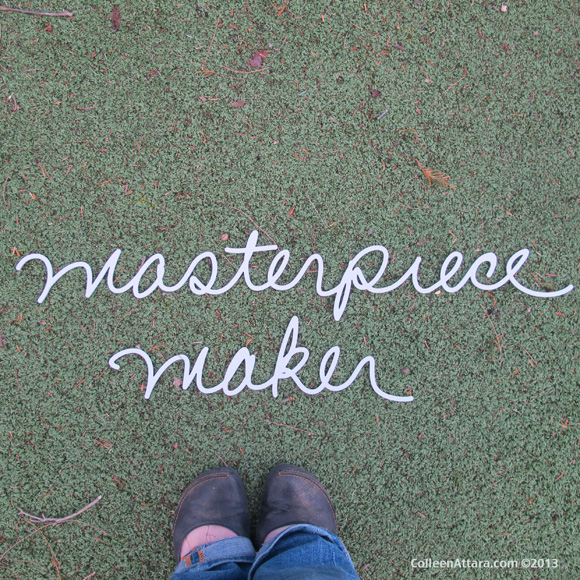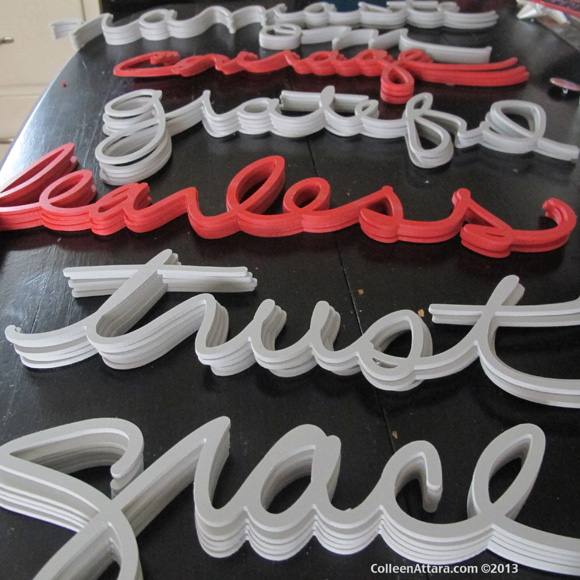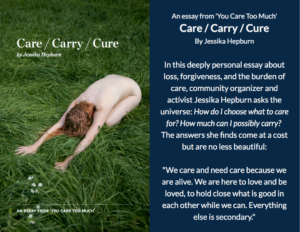

I am an eco-artist and a treasure hunter. I see “yes” where others see “no”. * I see possibility where others see trash.
I paint vibrant cities on glass, plant colorful window box gardens in vacant cities and I hand-script affirming words as wall art. Salvaged plastic is used in all my work.
31 million tons of plastic waste was generated in the U.S in 2010. Only 8 percent was recycled.
Source: U.S. Environmental Protection Agency
I love knowing my artwork will keep plastic out of our landfills and blue oceans. While most of what I reuse is reclaimed plastic signage, some is scrap plastic packing material and I can often be found picking pieces out of huge recycling bins. I have a fondness for rejected wall paint and old windows, which is the beginning of my story and still a part of what I do.
All of these materials have a past with imperfections. I find them, have them cut into the shapes I need to work with, then I take them back to my cottage studio where I sand and shine them all up with love. When you reuse, there is an element of unpredictability in the process. You have to find it first. Sometimes I meet people at shows and they ask me, “How did you come up with all this?”
The answer is I trusted the process. Part of the color and joy that comes out of my work is because the materials are imperfect. I have to work a bit harder to make it all shine. It takes me places and I follow.
There are more obstacles to jump over so I learned to jump a little bit higher. And I learned a few other things along the way too.

The easy way is probably not the way for you, although it would be nice
A few years ago, I installed a 70 foot-long installation in a new hospital made from all reclaimed materials. It was a huge project. It was created out of all scrap plastic signage. Part of the installation included a bridge that had five sections. When we went to cut the last section, there was not enough scrap to cut it. I had two choices; cut it using new material or take that one section of the bridge home with no legs, find more scrap and have the legs cut later, then reattach them. I picked option #2.
Standing true to your values becomes part of your story
That little section of the bridge was what I talked about in press interviews because it described the whole project perfectly.
I could show where the legs of the bridge were attached on that one section. I didn’t have to talk about my values. I could point to them.

Partner with people who know your values and will honor them
Let’s go back to the bridge. The company that did the cutting could have just cut that bridge and not told me we had run out of materials. But they were completely aligned with my values. They let me know my choices, which is their job. They point out the easier path, not expecting me to take it. Standing by my values has strengthened our working relationship. People like to work with people who are what they say they are, even when it is not convenient.
Figure out how it is a win-win for everyone
Because I use salvaged materials, I rarely pay for the materials. Instead I pay for each cut. And I have lots of material cut. So materials with no value now have value for everyone. And companies have a reason to save materials for me.
Ask the right people the right questions. Then listen carefully
Making a commitment to just use recycled materials can seem limiting when you come up with new ideas. The easiest way for me to work through this has been to talk it over with the businesses I partner with for materials. They point me in the right direction and put me on a straighter path. They understand the materials I am working with much better than I do because they use them every day on a larger scale. They take my idea and make it doable.

You have to be true to your values all the time but know there will be compromises
About 75% of what I wear comes from thrift and consignment stores. I find ways to reuse and redistribute clothing and items we have out grown. All of my cleaning products are earth friendly. I buy local as often as possible. I carry plastics and recycles home to dispose of properly. I find creative ways to reuse everything. My latest discovery: that a used dryer sheet is an amazing dust cloth-dust just sticks to it.
But sometimes you will have to choose between green and practicality. As much as I would love to drive an electric car that gets 50 miles per gallon, I pick up huge sheets of reused plastic signage often. And I drive it from point A to point B. It has to be in a big sheet for it to work for me. Looking for and picking the right piece of plastic signage is part of my business. And I need a big enough vehicle to do it in. So I drive a Jeep Wrangler. They are all made in the U.S. and I love that-and I just love driving a Jeep.
Come up with plan “B” and “C”. No wasting allowed.
Sometimes the words I get cut are just too scratched and dented to sell. Or a recycled flower has marks left over from the sign it was cut from. Their past has really caught up with them. So I came up with plan B, which is a little drawer of my “seconds” to sell at shows. And I have a plan C too. I prime the dented words and include them as extras in orders, all ready to be collaged or painted. There is opportunity in everything. Any flower that has any extra marks will be growing beautifully outside my studio this spring.
Scrap has scrap. There is opportunity here.
All the words that I cut are hand-scripted. The little loops in my cursive have little bits of teardrop shaped plastic that I pop out. I save theses pieces in jars on the highest shelf of my studio cabinet. I trust the process. Ideas are forming. They will become earrings, pieces of a chandelier, or part of a mobile. Put this scrap aside and let your subconscious go to work. Trust me on this. Ideas will come.
*A big thank-you to Dyana Valentine for knowing what my gift is. I see “yes” where others see “no”.
Are you running a green business? What lessons have you learned along the way? Are you considering making your business green or greener? I would love to hear from you.

